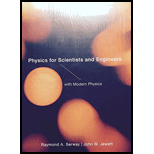
Concept explainers
(a)
Speed of the projectile when it leaves the barrel.
(a)
Answer to Problem 21P
Speed of the projectile when it leaves the barrel is
Explanation of Solution
In the system elastic potential energy is due to the spring and as friction force is acting on the ball total energy of the system is due to kinetic energy, eleastic potential energy and energy due to frictional force.
When the cannon is fired initial speed of the ball is zero as initially ball is at rest so, initial kinetic energy of the system is zero and spring finally returns to equilibriam so final elastic potential energy is also zero.
Write the expression for change in kinetic energy of the system.
Here,
Write the expression for change inelastic potential energy.
Here,
Write the expression for total internal energy.
Here,
Total energy of the system remains conserved therefore sum of all energies is equal to zero.
Write the expression for change conservation of energy for the system.
Substitute
Substitute
Multiply above equation by
Rearrange the above equation for
Conclusion:
Substitute
Thus, Speed of the projectile when it leaves the barrel is
(b)
The distance at which the ball has maximum speed.
(b)
Answer to Problem 21P
The distance at which the ball has maximum speed is
Explanation of Solution
The ball has maximum speed when there is no further acceleration. It happens when the force due to spring acting on the ball is equal to frictional force.
Here,
Write the expression for force due to spring on the ball.
Here,
Substitute
Rearrange the above equation for
Write the expression for distance where the speed is maximum.
Here,
Conclusion:
Substitute
Substitute
Thus, the distance at which the ball has maximum speed is
(c)
Maximum speed at the point asked in part (b).
(c)
Answer to Problem 21P
Maximum speed at the point asked in part (b) is
Explanation of Solution
At this point initial speed of the ball is zero as initially ball is at rest so, initial kinetic energy of the system is zero .
Substitute
Rearrange above equation.
Multiply above equation by
Rearrange above equation for
Conclusion:
Substitute
Thus, the maximum speed at the point asked in part (b) is
Want to see more full solutions like this?
Chapter 8 Solutions
Physics For Scientists And Engineers With Modern Physics, 9th Edition, The Ohio State University
- 3. If the force of gravity stopped acting on the planets in our solar system, what would happen? a) They would spiral slowly towards the sun. b) They would continue in straight lines tangent to their orbits. c) They would continue to orbit the sun. d) They would fly straight away from the sun. e) They would spiral slowly away from the sun. 4. 1 The free-body diagram of a wagon being pulled along a horizontal surface is best represented by A F N B C 0 Ꭰ FN E a) A b) B c) C app app The app 10 app d) e) ס ח D E 10 apparrow_forwardPls help ASAParrow_forwardPls help asaparrow_forward
- Pls help asaparrow_forwardThe acceleration of an object sliding along a frictionless ramp is inclined at an angle 0 is 9. a) g tano b) g cose c) g sino 10. d) g e) zero A 1.5 kg cart is pulled with a force of 7.3 N at an angle of 40° above the horizontal. If a kinetic friction force of 3.2 N acts against the motion, the cart's acceleration along the horizontal surface will be a) 5.0 m/s² b) 1.6 m/s² c) 2.4 m/s² 11. d) 1.0 m/s² e) 2.7 m/s² What is the net force acting on an object with a mass of 10 kg moving at a constant velocity of 10 m/s [North]? a) 100 N [North] b) 100 N [South] 10 N [North} d) 10 N [South] e) None of these.arrow_forwardModified True/False - indicate whether the sentence or statement is true or false. If the statement is false, correct the statement to make it true. 12. An object in uniform circular motion has a constant velocity while experiencing centripetal acceleration. 13. An object travelling in uniform circular motion experiences an outward centrifugal force that tends to pull the object out of the circular path. 14. An object with less inertia can resist changes in motion more than an object with more inertia. 15. For an object sliding on a horizontal surface with a horizontal applied force, the frictional force will always increase as the applied force increases.arrow_forward
- Pls help asaparrow_forwardAnswer the given question showing step by step by and all necessary working out.arrow_forward1. The piston in the figure has a mass of 0.5 kg. The infinitely long cylinder is pushed upward at a constant velocity. The diameters of the cylinder and piston are 10 cm and 9 cm, respectively, and there is oil between them with v = 10⁻⁴ m^2/s and γ = 8,000 N/m³. At what speed must the cylinder ascend for the piston to remain at rest?arrow_forward
 Principles of Physics: A Calculus-Based TextPhysicsISBN:9781133104261Author:Raymond A. Serway, John W. JewettPublisher:Cengage Learning
Principles of Physics: A Calculus-Based TextPhysicsISBN:9781133104261Author:Raymond A. Serway, John W. JewettPublisher:Cengage Learning Physics for Scientists and Engineers, Technology ...PhysicsISBN:9781305116399Author:Raymond A. Serway, John W. JewettPublisher:Cengage Learning
Physics for Scientists and Engineers, Technology ...PhysicsISBN:9781305116399Author:Raymond A. Serway, John W. JewettPublisher:Cengage Learning University Physics Volume 1PhysicsISBN:9781938168277Author:William Moebs, Samuel J. Ling, Jeff SannyPublisher:OpenStax - Rice University
University Physics Volume 1PhysicsISBN:9781938168277Author:William Moebs, Samuel J. Ling, Jeff SannyPublisher:OpenStax - Rice University Physics for Scientists and Engineers with Modern ...PhysicsISBN:9781337553292Author:Raymond A. Serway, John W. JewettPublisher:Cengage Learning
Physics for Scientists and Engineers with Modern ...PhysicsISBN:9781337553292Author:Raymond A. Serway, John W. JewettPublisher:Cengage Learning Physics for Scientists and EngineersPhysicsISBN:9781337553278Author:Raymond A. Serway, John W. JewettPublisher:Cengage Learning
Physics for Scientists and EngineersPhysicsISBN:9781337553278Author:Raymond A. Serway, John W. JewettPublisher:Cengage Learning Physics for Scientists and Engineers: Foundations...PhysicsISBN:9781133939146Author:Katz, Debora M.Publisher:Cengage Learning
Physics for Scientists and Engineers: Foundations...PhysicsISBN:9781133939146Author:Katz, Debora M.Publisher:Cengage Learning





